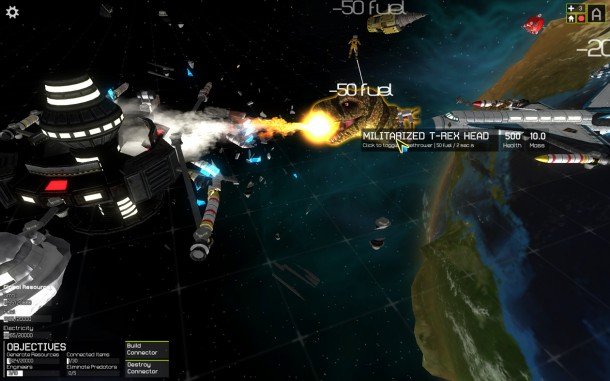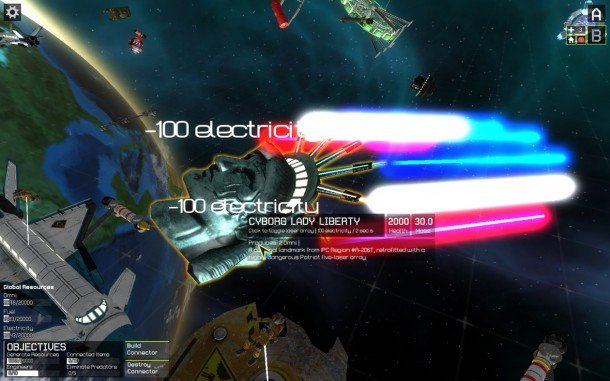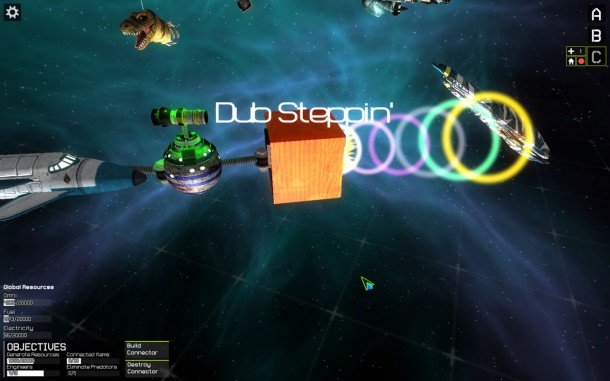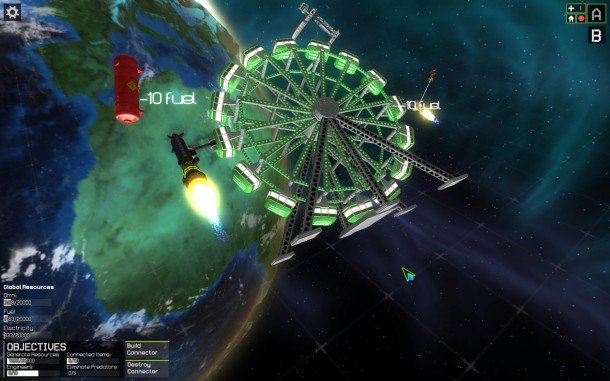Habitat review (Early Access)

Alpha and Early Access reviews offer our preliminary verdicts on in-development games. We may follow up this unscored review with a final, scored review in the future. Read our full review policy for details.
The planet Earth, malformed and scarred from some unthinkable cataclysm, now sports a massive ring of orbiting space debris, some of it very unusual. Along with items you might expect to find floating around in a sci-fi game, like booster rockets, laser cannons, and abandoned space shuttles, you'll also find ferris wheels, hamburger restaurants, enormous buzzsaw blades, and the head of a giant mechanical fire-breathing Tyrannosaurus Rex. Your job is to cobble together this space flotsam to build bizarre weaponized space stations capable of supporting life and dishing out death.
How these items got up here, or why some even exist at all—such as the severed head of a cyborg Statue of Liberty—isn't important. The point is, they're the key to your survival if you can mash enough of them together. Clicking a piece of debris and dragging it to a location will instruct one of your loyal yet highly-expendable engineers to fly out, nab it, and push it to the spot you've chosen. If two items are close enough, the engineer can weld them together. Rockets and boosters can be lassoed and attached to shuttles, then fired either separately or together to move your ship around in the debris field. Weapons, gas tanks, cargo containers, and anything else you find can be attached to your growing habitat.

Goals and objectives are pretty scant at this stage. You're told to generate resources like fuel, electricity, and omni (an undefined, multipurpose resource) all which come as a by-product of sticking parts and pieces together. You're also told to increase your crew to ten engineers, which is just a matter of clicking the plus symbol when you've got enough resources to support them. Another goal, connecting thirty pieces of junk together, is a little challenging—complex habitats occasionally explode when their parts bump one another or when fired boosters vibrate too much—but you can build several separate habitats at once, making it easier to use more parts.
There's also the reason for all those lasers and rocket-launchers: destroying enemies, though I was a little confused as to what actually constitutes an enemy. I attacked one nearby space platform, simply because I wanted to test my giant sawblade and fire-breathing dino-head. The station was inert, did not offer any resistance, yet when I destroyed it I was credited with eliminating a "predator." Another space station opened fire on a lone astronaut who had become separated from my crew, and proceeded to noisily bombard him for about ten minutes, never killing him and never moving from its spot in orbit. By the time I assembled a new ship to engage, the enemy station had already exploded on its own.

Beyond sticking together a bunch of oddball objects, trying to fly in a straight line, and seeing what various weapons do, there's not a whole lot of gameplay at the moment and only the sandbox mode to occupy yourself with. In fact, you can't even stop working on your orbiting masterpiece and come back later: there's currently no way to save your creation. A save feature is coming, according to the developer, but in the meantime don't get too attached to anything you attach to anything else.
Habitat has a good sense of humor and there are some funny objects to find in orbit, but as is often the case with jokes in games, one look is generally enough. A giant speaker that shoots colorful dubstep rays is amusing the first-time you activate it, as are the giant metal Hadouken hands that launch fireballs and Lady Liberty's red, white, and blue laser field. After that, though, I just scrolled past them and looked for more useful items. The exception is the fire-breathing T-rex head. That simply never gets old.
The biggest gaming news, reviews and hardware deals
Keep up to date with the most important stories and the best deals, as picked by the PC Gamer team.

Verdict
There's an hour or so of light, aimless entertainment here, provided you don't mind losing your work when you quit. I don't see much reason to revisit Habitat until it's closer to release.
Outlook
Unclear. None of the stretch goals were met during Habitat's Kickstarter campaign, so elements like multiplayer and modding support, both of which this game could make good use of, might never be a reality. A campaign mode is promised, which would add needed structure, and while the developers are promising frequent updates, the game hasn't been on Early Access long enough to establish a track record (though their first update was on time).
Details
Version reviewed: Version 0.11, July 22, 2014
Reviewed on: Intel i7, 2.8 GhZ, 8 GB RAM, Nvidia GeForce 660 Ti
Recommended: Dual core 2gHz processor, 2 GB RAM, Nvidia GTX 550 or higher
Price: $15/£11
Publisher: 4gency
Developer: Versus Evil LLC.
Multiplayer: Single-player only
Link: Steam store page

Chris started playing PC games in the 1980s, started writing about them in the early 2000s, and (finally) started getting paid to write about them in the late 2000s. Following a few years as a regular freelancer, PC Gamer hired him in 2014, probably so he'd stop emailing them asking for more work. Chris has a love-hate relationship with survival games and an unhealthy fascination with the inner lives of NPCs. He's also a fan of offbeat simulation games, mods, and ignoring storylines in RPGs so he can make up his own.

